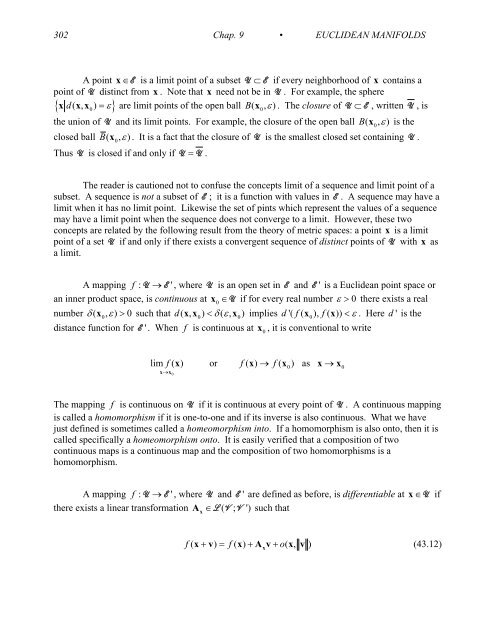Introduction to Vectors and Tensors Vol 2 (Bowen 246). - Index of
Introduction to Vectors and Tensors Vol 2 (Bowen 246). - Index of
Introduction to Vectors and Tensors Vol 2 (Bowen 246). - Index of
Create successful ePaper yourself
Turn your PDF publications into a flip-book with our unique Google optimized e-Paper software.
302 Chap. 9 • EUCLIDEAN MANIFOLDS<br />
A point x ∈E is a limit point <strong>of</strong> a subset U ⊂ E if every neighborhood <strong>of</strong> x contains a<br />
point <strong>of</strong> U distinct from x . Note that x need not be in U . For example, the sphere<br />
{ x d( x, x<br />
0)<br />
= ε}<br />
are limit points <strong>of</strong> the open ball B( x<br />
0, ε ). The closure <strong>of</strong> U ⊂ E , written U , is<br />
the union <strong>of</strong> U <strong>and</strong> its limit points. For example, the closure <strong>of</strong> the open ball B( x<br />
0, ε ) is the<br />
closed ball B( x<br />
0, ε ). It is a fact that the closure <strong>of</strong> U is the smallest closed set containing U .<br />
Thus U is closed if <strong>and</strong> only if U = U .<br />
The reader is cautioned not <strong>to</strong> confuse the concepts limit <strong>of</strong> a sequence <strong>and</strong> limit point <strong>of</strong> a<br />
subset. A sequence is not a subset <strong>of</strong> E ; it is a function with values in E . A sequence may have a<br />
limit when it has no limit point. Likewise the set <strong>of</strong> pints which represent the values <strong>of</strong> a sequence<br />
may have a limit point when the sequence does not converge <strong>to</strong> a limit. However, these two<br />
concepts are related by the following result from the theory <strong>of</strong> metric spaces: a point x is a limit<br />
point <strong>of</strong> a set U if <strong>and</strong> only if there exists a convergent sequence <strong>of</strong> distinct points <strong>of</strong> U with x as<br />
a limit.<br />
A mapping f : U →E ', where U is an open set in E <strong>and</strong> E ' is a Euclidean point space or<br />
an inner product space, is continuous at x ∈ 0<br />
U if for every real number ε > 0 there exists a real<br />
number δ ( x<br />
0, ε ) > 0 such that d( xx ,<br />
0) < δ ( ε, x<br />
0)<br />
implies d'( f( x0), f( x )) < ε . Here d ' is the<br />
distance function for E ' . When f is continuous at x<br />
0<br />
, it is conventional <strong>to</strong> write<br />
lim f( x) or f( x) → f( x ) as x→x<br />
x→x0<br />
0 0<br />
The mapping f is continuous on U if it is continuous at every point <strong>of</strong> U . A continuous mapping<br />
is called a homomorphism if it is one-<strong>to</strong>-one <strong>and</strong> if its inverse is also continuous. What we have<br />
just defined is sometimes called a homeomorphism in<strong>to</strong>. If a homomorphism is also on<strong>to</strong>, then it is<br />
called specifically a homeomorphism on<strong>to</strong>. It is easily verified that a composition <strong>of</strong> two<br />
continuous maps is a continuous map <strong>and</strong> the composition <strong>of</strong> two homomorphisms is a<br />
homomorphism.<br />
A mapping f : U →E ' , where U <strong>and</strong> E ' are defined as before, is differentiable at<br />
there exists a linear transformation A ∈LV ( ; V ') such that<br />
x<br />
x ∈U if<br />
f( x+ v) = f( x) + A v+<br />
o( x, v )<br />
(43.12)<br />
x

















